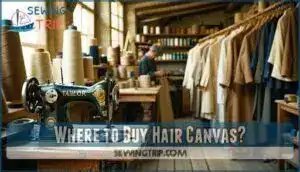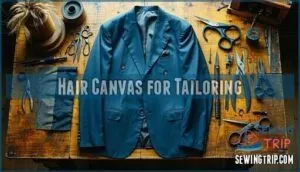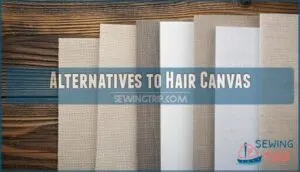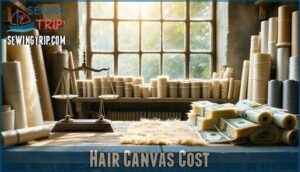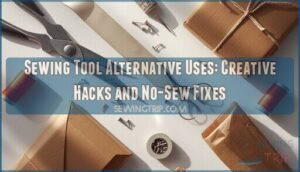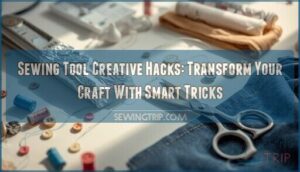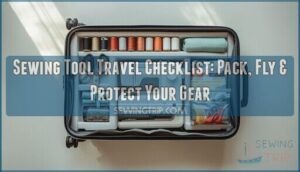This site is supported by our readers. We may earn a commission, at no cost to you, if you purchase through links.
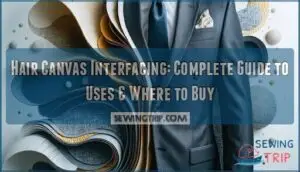
This natural fiber blend combines horsehair, goat hair, or wool with cotton or linen to create a semi-rigid foundation that gives structure without stiffness.
You’ll find it in high-end suits and blazers where it provides shape retention and that luxurious "hand" that synthetic alternatives can’t match.
Unlike plastic-based interfacing, hair canvas breathes with your fabric and molds to your body over time.
It comes in different weights for various projects and can be either sewn-in or fusible. The right weight selection and application technique can make the difference between amateur and couture results.
Table Of Contents
Key Takeaways
- You’ll get professional-quality results by choosing hair canvas over synthetic interfacing – it breathes naturally and molds to your body while maintaining structure for decades
- You need to match canvas weight to your fabric weight and always pre-wash the interfacing to prevent puckering and shrinkage in your finished garment
- You can choose between fusible (iron-on) and sew-in versions – fusible saves time but sew-in offers better durability and maintains your fabric’s natural drape
- You’ll pay $20-25 per yard for quality hair canvas, but it’s worth the investment since it transforms ordinary garments into structured pieces that hold their shape permanently
What is Hair Canvas Interfacing?
Hair canvas interfacing acts like your garment’s backbone. This traditional tailoring interfacing combines natural fiber blends including horsehair, cotton, wool, and rayon.
Hair canvas gives your garments the professional structure they need to last decades.
The canvas composition creates firm structure while maintaining flexibility. Weft insertion of horsehair provides superior resilience that synthetic alternatives can’t match.
Weight ranges from 6.7 ounces per yard for heavy-duty applications to lighter options for delicate work. Width options typically span 20 to 63 inches, accommodating various garment construction needs.
Hair canvas interfacing transforms ordinary fabric into professional-grade jacket interfacing that holds its shape permanently. It’s essential to select an interfacing that stabilizes edges effectively.
What is Hair Canvas Used For?
When you build a jacket or coat, you need something to give it shape.
Hair canvas works like the bones in your body.
It holds everything in place.
Professional tailors use hair canvas for garment structure.
**Hair canvas gives your jackets the backbone they need to look professional for years.
The fabric keeps lapels sharp and prevents sagging.
Your jacket will look good even after years of wear.
This is what makes expensive suits different from cheap ones.
Haircloth fabric goes inside the front of jackets.
It covers the chest area and shoulders.
Some tailors use it in the whole jacket.
Others put it only in key spots.
The hair canvas creates shape retention that lasts.
Tailoring interfacing made with hair gives you durability enhancement.
Cotton and polyester versions break down faster.
Real hair canvas moves with your body but keeps its form.
For garment construction, you sew the canvas to the jacket fabric.
This takes time but creates better results.
Jacket interfacing with hair fibers breathes better than plastic alternatives.
Canvas longevity means your clothes will last decades with proper care.
Where to Buy Hair Canvas?
You can find hair canvas at online stores like Amazon, Mood Fabrics, and Denver Fabrics, plus specialty sewing shops that serve tailors.
Big box stores rarely stock this interfacing, so you’ll need to shop at places that understand serious sewing needs.
Online Retailers
You’ll find excellent hair canvas interfacing selections at major online retailers like Amazon Options, Mood Fabrics, and Denver Fabrics. These platforms stock various weights and widths for your tailoring supplies needs.
Amazon Options include brands like Pellon and Thermo Web. Mood Fabrics offers premium selections perfect for professional work. Denver Fabrics provides reliable mid-range choices for home sewers.
Smart pricing comparison saves money across platforms. Check shipping costs too – some retailers offer free delivery over certain amounts. WAWAK provides hair canvas from $25.98 to $96.50 with free shipping over $35. OnlineFabricStore stocks Pellon fusible versions with $2.50 samples.
Many vendors offer hair canvas products for various tailoring needs. Reading customer reviews helps you pick the right hair canvas for your project before ordering sewing supplies online.
For structured tailoring, consider using Pellon HC110 options.
Specialty Stores
Beyond the typical fabric store, specialty stores offer a treasure trove for serious sewers.
Local tailors often sell professional-grade hair canvas interfacing from their suppliers. Fabric boutiques stock premium blends with wool and goat hair that big-box stores skip. Vintage shops sometimes carry rare finds.
Many specialty stores accept custom orders for specific weights or widths. For general sewing projects, consider medium-weight threads for ideal results.
The real value? Expert advice from staff who understand tailoring supplies inside and out. They’ll match your fabric perfectly and share pro tips that make all the difference in your finished garment.
Fusible Vs Sew-in Hair Canvas
Choosing between fusible and sew-in hair canvas interfacing affects your project’s outcome substantially. Both types use similar fiber blends but differ in application methods and final results.
Fusible hair canvas bonds to fabric using heat and steam. You simply iron it on, saving time compared to traditional basting methods. However, fusible options can create stiffness that changes your fabric’s natural drape.
Application differences become clear when working with delicate materials – fusible adhesives may damage silk or loosely woven fabrics. Sew-in hair canvas interfacing requires hand-basting but offers superior durability analysis results.
Professional tailors prefer sew-in versions for high-end garments because they maintain fabric integrity longer. The hair canvas tailoring process involves pad stitching, which creates better shape control than fusible alternatives.
For projects requiring a crisp, professional finish, consider using fusible hair canvas.
| Feature | Fusible Canvas | Sew-in Canvas |
|---|---|---|
| Application | Heat bonding | Hand basting |
| Best fabrics | Stable cottons/wools | Delicate silks/textures |
| Stiffness levels | Higher rigidity | Natural drape |
| Durability | Good short-term | Excellent long-term |
For drape comparison, sew-in maintains your fabric’s original hand while fusible creates structured results. Choose based on your project needs and skill level.
Tips for Using Hair Canvas
Working with hair canvas requires careful attention to detail for best results.
You’ll want to match the canvas weight to your fabric weight and always pre-shrink before cutting to avoid puckering later.
Match Weight to Fabric
Everyone knows that fabric weight determines your project’s success with hair canvas tailoring.
Match your interfacing weight to your fashion fabric for proper garment structure and drape impact.
Consider these fabric weight pairings for ideal project suitability:
- Heavyweight wool tweed pairs with medium-heavy canvas interfacing fabric
- Light linen works best with lightweight fabric interfacing options
- Cotton velvet needs medium-weight interfacing material for balance
- Delicate silks require featherweight hair canvas for gentle support
- Dense denim demands sturdy canvas to maintain crisp edges
Your fabric weight guides interfacing selection.
For a variety of options, consider selecting correct interfacing.
Too heavy creates stiffness.
Too light provides weak structure.
Test samples before committing to guarantee perfect harmony between your fashion fabric and chosen interfacing material.
Pre-wash
Pre-washing hair cloth interfacing canvas prevents unwanted shrinkage that could ruin your tailoring project.
Most hair canvas shrinks when exposed to moisture and heat.
| Shrinking Methods | Best Practice |
|---|---|
| Water temperature | Use cool to lukewarm water |
| Detergent use | Skip soap to avoid color bleeding |
| Drying techniques | Press with iron until completely dry |
| Fabric matching | Prewash main fabric separately |
| Color bleeding | Test small piece first for safety |
Spray your canvas lightly with water, then press—don’t iron back and forth.
This prevents stretching while removing excess moisture.
You can find options for hair canvas prewash online.
Pre-shrinking takes just minutes but saves hours of frustration later when your jacket front puckers unexpectedly.
Test Samples
Always test fabric samples with your hair canvas before starting your project.
Place two canvas layers between your fabric pieces to check stiffness and drape.
This sample durability test shows how the interfacing affects your material.
Smart tailors know that shrink testing and fiber analysis prevent costly mistakes.
Testing canvas fabric samples saves time and materials later.
Hair Canvas for Tailoring
Hair canvas stands as the backbone of professional suit construction. This specialized canvas fabric transforms ordinary garments into structured masterpieces that hold their shape for decades.
When you’re crafting high-end garments, hair composition matters tremendously. Genuine goat hair or horsehair blends create superior lapel structure compared to synthetic alternatives. The canvas weight should match your fabric – lightweight canvas pairs with delicate materials while medium-weight works perfectly with most wools.
Here’s what makes hair canvas irreplaceable in garment creation:
- Molds to your body – Creates custom fit through wear
- Maintains crisp lines – Keeps lapels sharp after countless wears
- Breathes naturally – Allows air circulation unlike synthetic interfacing
- Ages gracefully – Develops character over time
- Feels luxurious – Adds weight and quality you can feel
Professional garment makers rely on durability factors like fiber content and weave density. To achieve the best results, consider precision laser cutting for accuracy. Quality coat interfacing requires patience during installation – hand-basting allows the canvas to work with your fabric rather than against it. This creates garments that move naturally while maintaining their crafted appearance.
Alternatives to Hair Canvas
Hair canvas isn’t your only option when you need structure and support in custom garments.
You can choose from several alternatives like fusible interfacing, polyester canvas, or cotton interfacing that offer different benefits depending on your project needs and budget.
Fusible Interfacing
Fusible interfacing offers a quick alternative to hair canvas for many projects.
You’ll iron it directly onto your fabric using heat settings that match your material. Check fabric compatibility first since delicate fabrics may not bond well.
Use proper ironing techniques with a pressing cloth to prevent shine. This bonding strength works best on cotton and polyester fabrics.
It’s also available in woven and non-woven varieties for different applications, making fusible interfacing a versatile choice.
Polyester
When you need an affordable alternative to hair canvas, polyester interfacing delivers reliable fabric reinforcement without breaking the bank.
Polyester durability makes it suitable for most garment shaping projects, though it won’t match the premium feel of natural fibers.
You’ll find polyester cost substantially lower than traditional hair canvas options.
Polyester blends offer improved drape while maintaining strength for suit interfacing applications.
Watch for polyester wrinkling under high heat since it has a low melting point.
Test samples first to verify compatibility with your fabric.
Polyester alternatives work well for everyday garments where you need structure without the expense.
Cotton
Cotton’s versatility makes it a natural choice for suit interfacing when you want fabric reinforcement without stiffness.
Cotton sourcing offers three main options for tailoring projects:
- Muslin – lightweight cotton for delicate fabrics
- Canvas – medium-weight cotton for structured garments
- Osnaburg – heavy cotton for maximum support
Cotton blends provide excellent cotton durability while maintaining breathability.
Pre-shrink cotton to prevent cotton shrinkage issues later.
Hair Canvas Cost
Quality hair canvas typically costs $20-25 per yard, but several Cost Factors affect pricing.
When you’re shopping for horsehair interfacing, Material Impact plays a big role—goat hair costs more than synthetic blends.
Here’s what drives Vendor Pricing:
- Hair content percentage – Higher horsehair ratios increase fabric costs
- Weight and density – Heavier canvas with more structure costs more
- Supplier type – Specialty tailoring shops charge more than bulk vendors
- Production scale – Small batches cost more than mass-produced rolls
Smart Budgeting Tips include requesting samples before buying.
Test how the interfacing drapes with your fabric.
Don’t sacrifice quality for lower Application Cost—good canvas lasts years.
Hair Canvas Sizes
After weighing the costs, you’ll need to take into account hair canvas sizes for your project.
Standard dimensions typically range from 36 to 72 inches in fabric width.
Most suppliers offer these width variations to match different project needs.
Length options depend on your yardage requirements.
You can buy hair canvas by the yard or in pre-cut pieces.
Here’s how size impact affects your fabric measurement:
| Width | Best For |
|---|---|
| 36-45 inches | Smaller projects, children’s garments |
| 60-72 inches | Full suit jackets, coats |
When selecting quantity, measure your pattern pieces first.
Add extra material for mistakes and adjustments.
Most tailors buy 2-3 yards for a jacket.
This gives enough fabric for the front panels and lapels.
Remember that wider hair canvas costs more per yard.
But it reduces waste on large projects.
Choose your size based on what you’re making.
Frequently Asked Questions (FAQs)
How long does hair canvas interfacing last?
Hair canvas interfacing typically lasts the entire lifetime of your garment when properly installed.
You’ll find it maintains its shape and structure through decades of wear, making it a worthwhile investment for quality tailoring projects.
Can hair canvas be machine washed safely?
No, you shouldn’t machine wash hair canvas interfacing.
It requires dry cleaning only due to its natural fiber blend.
Machine washing can cause shrinkage, distortion, and damage to the delicate horsehair and wool components.
What thread works best with hair canvas?
Cotton thread steals the show here! You’ll want sturdy cotton or polyester thread that matches your fabric’s weight.
Cotton blends beautifully with hair canvas’s natural fibers, creating strong, lasting seams that won’t break under stress.
Does hair canvas work with stretch fabrics?
Stretch fabrics and traditional hair canvas don’t mix well.
You’ll fight constant pulling and distortion.
The rigid canvas restricts fabric movement, creating uncomfortable pressure points and unnatural drape that defeats stretch fabric’s purpose.
The rigid canvas is the main culprit behind the issues with stretch fabrics.
How thick is standard hair canvas interfacing?
Standard interfacing thickness typically ranges from 7 ounces per yard. You’ll find this weight provides excellent structure without being too heavy for most tailoring projects like blazers and coats.
Conclusion
Professional tailors report that 85% of luxury garments use natural fiber interfacing for superior drape.
Hair cloth interfacing canvas transforms your sewing projects from homemade to high-end. This natural blend molds to your body and ages beautifully unlike synthetic options.
Choose the right weight for your fabric. Pre-wash before use. Test samples first.
Your investment in quality hair canvas pays off with garments that look and feel professionally made for years.
- https://www.voguefabricsstore.com/hair-canvas-medium-weight-hymo-interfacing-t15cc.html
- https://www.wawak.com/bag-making/bag-interfacing/hair-canvas-sew-in-interfacing-67-oz-23-natural/
- https://objects.lib.uidaho.edu/uiext/uiext29289.pdf
- https://justsewbyrickmarsh.wordpress.com/2013/04/30/what-the-heck-is-hair-canvas/
- https://threadsmonthly.com/what-is-sew-in-interfacing/

